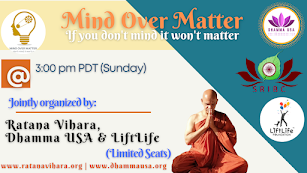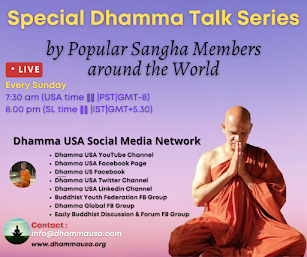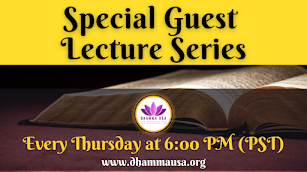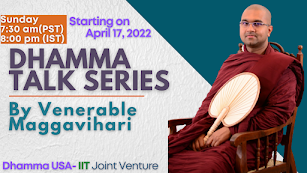"Gradual Teaching" (anupubbiṁ kathaṁ)
Dhamma Talk Series – Part 7 Empty Cloud Monastery, New Jersey conducted by Bhante Sumitta
Buddhānaṃ sāmukkaṃsikā dhammadesanā - dukkhaṃ samudayaṃ nirodhaṃ maggaṃ
1) Dānakathaṃ - (Talk on Generosity) 2) Sīlakathaṃ - (Talk on Morality) 3) Saggakathaṃ - (Talk on Heavens) 4) Kāmānaṃ ādīnavaṃ okāraṃ saṁkilesaṃ (Danger, degredation and defilement of sensual pleasures) 5) Nekkhamme ānisaṁsaṃ (Benefits of Renunciation) 6) Kallacittaṃ muducittaṃ vinīvaraṇacittaṃ udaggacittaṃ pasannacittaṃ (Ready mind, pliable mind, open mind, uplifted mind, confident mind) 7) Buddhānaṃ sāmukkaṃsikā dhammadesanā - dukkhaṃ samudayaṃ nirodhaṃ maggaṃ (Doctrine of the Enlightened Ones - suffering, cause of suffering, cessation of suffering, path leading to the cessation of suffering) 8) Dhammacakkhuṁ udapādi - 'yaṁ kiñci samudayadhammaṁ sabbaṁ taṁ nirodhadhammaṁ" (Eye of Dhamma opened - whatever has the nature of arising, all that has nature of ceasing)
Devatārādhanā (Invitation to the Devas)
Samantā cakkavālesu atrā gacchantu devatā
saddhammam munirājassa sunantu sagga mokkhadam
parittassavana kālo ayam bhadantā //
parittadhammassavana kālo ayam bhadantā
(From all round the world systems may the devas come here. The true Dhamma of the King of sages is to be heard; leading to heaven and liberation.)
Salutation to the Buddha
Namo tassa bhagavato arahato sammā sambuddhassa ///
(Homage to Him, the Blessed One, the Exalted One, the Fully Enlightened One!)Title Stanza:Tathāgatena, bhikkhave, arahatā sammāsambuddhena bārāṇasiyaṃ isipatane migadāye anuttaraṃ dhammacakkaṃ pavattitaṃ appaṭivattiyaṃ samaṇena vā brāhmaṇena vā devena vā mārena vā brahmunā vā kenaci vā lokasmiṃ, yadidaṃ– catunnaṃ ariyasaccānaṃ ācikkhanā desanā paññāpanā paṭṭhapanā vivaraṇā vibhajanā uttānīkammaṃ.Anupubbi Kathaṃ (Gradual Teaching) – Dhamma Talk Series – Part 7
MN 141- Saccavibhaṅga Sutta
Discourse on Analysis of the Four Noble TruthsEvaṃ me sutaṃ– ekaṃ samayaṃ bhagavā bārāṇasiyaṃ viharati isipatane migadāye. Tatra kho bhagavā bhikkhū āmantesi–‘‘ bhikkhavo’’ ti.‘‘Bhadante’’ ti te bhikkhū bhagavato paccassosuṃ. Bhagavā etadavoca–
Thus have I heard - on one occasion the Blessed One was living in the Deer Park at Isipatana (the Resort of Saints) near Varanasi (Benares). Then he addressed the monks saying: "O Monks." "Venerable Sir," replied those monks in assent to the Blessed One. Thereupon he said:
Tathāgatena, bhikkhave, arahatā sammāsambuddhena bārāṇasiyaṃ isipatane migadāye anuttaraṃ dhammacakkaṃ pavattitaṃ appaṭivattiyaṃ samaṇena vā brāhmaṇena vā devena vā mārena vā brahmunā vā kenaci vā lokasmiṃ, yadidaṃ– catunnaṃ ariyasaccānaṃ ācikkhanā desanā paññāpanā paṭṭhapanā vivaraṇā vibhajanā uttānīkammaṃ.
The matchless Wheel of Dhamma set in motion by the Tathagata,[1]the Consummate One, the supremely Enlightened One, in the Deer Park at Isipatana near Varanasi, cannot be set in motion by a recluse or brahmana or Deva or Mara or Brahma or by anyone in the world. That is to say, it was a proclamation of the Four Noble Truths, by way of teaching, laying down, establishing, opening up, analyzing, and elucidating them.Katamesaṃ catunnaṃ? Dukkhassa ariyasaccassa ācikkhanā desanā paññāpanā paṭṭhapanā vivaraṇā vibhajanā uttānīkammaṃ, dukkhasamudayassa ariyasaccassa ācikkhanā desanā paññāpanā paṭṭhapanā vivaraṇā vibhajanā uttānīkammaṃ, dukkhanirodhassa ariyasaccassa ācikkhanā desanā paññāpanā paṭṭhapanā vivaraṇā vibhajanā uttānīkammaṃ, dukkhanirodhagāminiyā paṭipadāya ariyasaccassa ācikkhanā desanā paññāpanā paṭṭhapanā vivaraṇā vibhajanā uttānīkammaṃ.
Of what four: It was a proclamation of the Noble Truth of suffering (dukkha), by way of teaching... (as before) and elucidating it; of the Noble Truth of the arising (cause) of suffering... of the Noble Truth of the cessation of suffering... of the Noble Truth of the Path leading to the cessation of suffering.
Tathāgatena, bhikkhave, arahatā sammāsambuddhena bārāṇasiyaṃ isipatane migadāye anuttaraṃ dhammacakkaṃ pavattitaṃ appaṭivattiyaṃ samaṇena vā brāhmaṇena vā devena vā mārena vā brahmunā vā kenaci vā lokasmiṃ , yadidaṃ– imesaṃ catunnaṃ ariyasaccānaṃ ācikkhanā desanā paññāpanā paṭṭhapanā vivaraṇā vibhajanā uttānīkammaṃ.
This matchless Wheel of Dhamma, monks, set in motion by the Tathagata, the Consummate One, the supremely Enlightened One, in the Deer Park at Isipatana near Varanasi, cannot be set in motion by a recluse... or by anyone in the world. That is to say, it was a proclamation of the Four Noble Truths, by way of teaching, laying down, establishing, opening up, analyzing, and elucidating them.
Sevatha, bhikkhave, sāriputtamoggallāne; bhajatha, bhikkhave, sāriputtamoggallāne. Paṇḍitā bhikkhū anuggāhakā sabrahmacārīnaṃ. Seyyathāpi, bhikkhave, janetā[ janetti( sī. pī.)], evaṃ sāriputto; seyyathāpi jātassa āpādetā, evaṃ moggallāno. Sāriputto, bhikkhave, sotāpattiphale vineti, moggallāno uttamatthe. Sāriputto, bhikkhave, pahoti cattāri ariyasaccāni vitthārena ācikkhituṃ desetuṃ paññāpetuṃ paṭṭhapetuṃ vivarituṃ vibhajituṃ uttānīkātun’’ ti.
Monks, follow Sariputta and Moggallana; associate with Sariputta and Moggallana. Wise monks do help (materially and spiritually) those who live the holy life. Monks, Sariputta is like unto a mother, Moggallana is like unto a foster-mother to a child. Sariputta, monks, trains (beings) in the path[2] of stream-attainment. Moggallana in the highest goal (arahantship).[3] Sariputta, monks, is able to proclaim, teach, lay down, establish, open up, analyze, and elucidate the Four Noble Truths."Idamavoca bhagavā. Idaṃ vatvāna sugato uṭṭhāyāsanā vihāraṃ pāvisi.
This the Blessed One said, and having said so, the Welcome Being (sugata)[4] rose from his seat and entered (his) abode.Tatra kho āyasmā sāriputto acirapakkantassa bhagavato bhikkhū āmantesi–‘‘āvuso, bhikkhave’’ ti.‘‘ Āvuso’’ ti kho te bhikkhū āyasmato sāriputtassa paccassosuṃ. Āyasmā sāriputto etadavoca-
Not long after the Blessed One had departed, the Venerable Sariputta addressed the monks, saying: "Reverend friends." "Your reverence," the monks replied the Venerable Sariputta in assent.
Tathāgatena, āvuso, arahatā sammāsambuddhena bārāṇasiyaṃ isipatane migadāye anuttaraṃ dhammacakkaṃ pavattitaṃ appaṭivattiyaṃ samaṇena vā brāhmaṇena vā devena vā mārena vā brahmunā vā kenaci vā lokasmiṃ, yadidaṃ– catunnaṃ ariyasaccānaṃ ācikkhanā desanā paññāpanā paṭṭhapanā vivaraṇā vibhajanā uttānīkammaṃ.
Your reverence, the matchless Wheel of Dhamma set in motion by the Tathagata, the Consummate One, the supremely Enlightened One, in the Deer Park, at Isipatana near Varanasi, cannot be set in motion by a recluse or brahmana... (as before) in the world. That is to say, it was a proclamation of the Four Noble Truths, by way of teaching, laying down, establishing, opening up, analyzing, and elucidating them.
Katamesaṃ catunnaṃ? Dukkhassa ariyasaccassa ācikkhanā desanā paññāpanā paṭṭhapanā vivaraṇā vibhajanā uttānīkammaṃ, dukkhasamudayassa ariyasaccassa ācikkhanā desanā paññāpanā paṭṭhapanā vivaraṇā vibhajanā uttānīkammaṃ, dukkhanirodhassa ariyasaccassa ācikkhanā desanā paññāpanā paṭṭhapanā vivaraṇā vibhajanā uttānīkammaṃ, dukkhanirodhagāminiyā paṭipadāya ariyasaccassa ācikkhanā desanā paññāpanā paṭṭhapanā vivaraṇā vibhajanā uttānīkammaṃ.
Of what four? It was a proclamation of the Noble Truth of suffering (dukkha) by way of teaching... elucidating it; of the Noble Truth of the arising of suffering... of the Noble Truth of the cessation of suffering... of the Noble Truth of the Path leading to the cessation of suffering.
Katamañcāvuso, dukkhaṃ ariyasaccaṃ? Jātipi dukkhā, jarāpi dukkhā, maraṇampi dukkhaṃ, sokaparidevadukkhadomanassupāyāsāpi dukkhā, yampicchaṃ na labhati tampi dukkhaṃ; saṃkhittena pañcupādānakkhandhā dukkh.
What, your reverence, is the Noble Truth of suffering? Birth is suffering; aging is suffering; death is suffering; grief, lamentation, bodily pain, mental pain and despair are suffering; not getting what one desires, that too is suffering: In brief the five aggregates subject to grasping are suffering.
Katamā cāvuso, jāti? Yā tesaṃ tesaṃ sattānaṃ tamhi tamhi sattanikāye jāti sañjāti okkanti abhinibbatti khandhānaṃ pātubhāvo āyatanānaṃ paṭilābho, ayaṃ vuccatāvuso–‘ jāti’’’.
What is birth? It is the birth of beings in the various classes (planes) of beings; the production, their conception, coming into existence (re-birth), the appearance of the aggregates, acquiring of the sense-bases. This is called birth.
Katamā cāvuso, jarā? Yā tesaṃ tesaṃ sattānaṃ tamhi tamhi sattanikāye jarā jīraṇatā khaṇḍiccaṃ pāliccaṃ valittacatā āyuno saṃhāni indriyānaṃ paripāko, ayaṃ vuccatāvuso–‘ jarā’’’.
What is aging? It is the aging of beings in the various classes of beings, their decay, broken teeth, graying hair, wrinkled skin, the dwindling of the life-span, the wearing out of the sense-organs. This is called aging.
Katamañcāvuso, maraṇaṃ? Yā tesaṃ tesaṃ sattānaṃ tamhā tamhā sattanikāyā cuti cavanatā bhedo antaradhānaṃ maccu maraṇaṃ kālaṃkiriyā khandhānaṃ bhedo kaḷevarassa nikkhepo jīvitindriyassupacchedo, idaṃ vuccatāvuso–‘ maraṇaṃ’’’.
What is death? It is the passing away of beings in the various classes of beings; the falling away, the breaking up, the disappearance, the death, making end of life, the breaking up of the aggregates, the laying down of the body. This is called death.
Katamo cāvuso, soko? Yo kho, āvuso, aññataraññatarena byasanena samannāgatassa aññataraññatarena dukkhadhammena phuṭṭhassa soko socanā socitattaṃ antosoko antoparisoko, ayaṃ vuccatāvuso –‘ soko’’’.
What is grief? It is the grief, sorrow, sorrowfulness, the state of being sorry, inward sorrow, inward intense sorrow visited by some calamity or other, smitten by some kind of ill or other. This is called grief.
Katamo cāvuso, paridevo? Yo kho, āvuso, aññataraññatarena byasanena samannāgatassa aññataraññatarena dukkhadhammena phuṭṭhassa ādevo paridevo ādevanā paridevanā ādevitattaṃ paridevitattaṃ, ayaṃ vuccatāvuso–‘ paridevo’’’.
What is lamentation? It is the crying, the wailing, the act of crying, the act of wailing, the state of crying, the state of wailing of one visited by some calamity or other, smitten by some kind of ill or other. This is called lamentation.
Katamañcāvuso, dukkhaṃ? Yaṃ kho, āvuso, kāyikaṃ dukkhaṃ kāyikaṃ asātaṃ kāyasamphassajaṃ dukkhaṃ asātaṃ vedayitaṃ, idaṃ vuccatāvuso–‘ dukkhaṃ’’’.
What is suffering? It is bodily suffering, bodily unpleasantness, the painful and unpleasant feeling produced by bodily contact. This is called suffering.
Katamañcāvuso, domanassaṃ? Yaṃ kho, āvuso, cetasikaṃ dukkhaṃ cetasikaṃ asātaṃ manosamphassajaṃ dukkhaṃ asātaṃ vedayitaṃ, idaṃ vuccatāvuso–‘ domanassaṃ’’’.
What is misery? It is mental suffering, unpleasantness, the painful and unpleasant feeling produced by mental contact. This is called misery.
Katamo cāvuso, upāyāso? Yo kho, āvuso, aññataraññatarena byasanena samannāgatassa aññataraññatarena dukkhadhammena phuṭṭhassa āyāso upāyāso āyāsitattaṃ upāyāsitattaṃ, ayaṃ vuccatāvuso–‘ upāyāso’’’.
What is despair? It is despondency, despair, the state of despondency, the state of despair of one visited by some calamity or other. This is called despair.
Katamañcāvuso, yampicchaṃ na labhati tampi dukkhaṃ? Jātidhammānaṃ, āvuso, sattānaṃ evaṃ icchā uppajjati–‘aho vata, mayaṃ na jātidhammā assāma; na ca, vata, no jāti āgaccheyyā’ ti. Na kho panetaṃ icchāya pattabbaṃ. Idampi–‘yampicchaṃ na labhati tampi dukkhaṃ’. Jarādhammānaṃ, āvuso, sattānaṃ… pe… byādhidhammānaṃ, āvuso, sattānaṃ… maraṇadhammānaṃ, āvuso, sattānaṃ… sokaparidevadukkhadomanassupāyāsadhammānaṃ, āvuso, sattānaṃ evaṃ icchā uppajjati–‘aho vata, mayaṃ na sokaparidevadukkhadomanassupāyāsadhammā assāma ; na ca, vata, no sokaparidevadukkhadomanassupāyāsā āgaccheyyun’ ti . Na kho panetaṃ icchāya pattabbaṃ. Idampi - ‘yampicchaṃ na labhati tampi dukkhaṃ’’’.
What is meant by not getting what one desires, that too is suffering? To beings subject to birth there comes desire: 'O might we not be subject to birth, and birth not come to us.' But this cannot be attained by mere desiring. So not getting what one desires, that too, is suffering. To beings subject to aging there comes the desire: 'O might we not be subject to aging, and aging not come to us...' (as before). To beings subject to disease there comes the desire: 'O might we not be subject to disease and disease not come to us...' To beings subject to death there comes the desire: 'O might we not be subject to death and death not come to us...' To beings subject to sorrow, lamentation, suffering, misery, and despair there comes the desire: 'O might we not be subject to sorrow, lamentation, suffering, misery, and despair, and sorrow, lamentation, suffering, misery, and despair not come to us.' But this cannot be attained by merely desiring. So not getting what one desires that too is suffering.
Katame cāvuso, saṃkhittena pañcupādānakkhandhā dukkhā? Seyyathidaṃ– rūpupādānakkhandho, vedanupādānakkhandho, saññupādānakkhandho, saṅkhārupādānakkhandho, viññāṇupādānakkhandho. Ime vuccantāvuso–‘ saṃkhittena pañcupādānakkhandhā dukkhā’. Idaṃ vuccatāvuso–‘ dukkhaṃ ariyasaccaṃ’’’.
What, in brief, are the five aggregates subject to grasping that are suffering? These are the aggregate of matter subject to grasping, the aggregate of feeling..., the aggregate of perception..., the aggregate of mental (volitional) formations..., the aggregate of consciousness subject to grasping. These are called, in brief, the five aggregates subject to grasping that are suffering. This is called the Noble Truth of suffering.
Katamañcāvuso, dukkhasamudayaṃ[ dukkhasamudayo( syā. kaṃ.)] ariyasaccaṃ? Yāyaṃ taṇhā ponobbhavikā[ ponobhavikā( sī. pī.)] nandīrāgasahagatā[ nandirāgasahagatā( sī. syā. kaṃ. pī.)] tatratatrābhinandinī, seyyathidaṃ– kāmataṇhā bhavataṇhā vibhavataṇhā , idaṃ vuccatāvuso–‘ dukkhasamudayaṃ[ dukkhasamudayo( syā. kaṃ.)] ariyasaccaṃ’’’.
What is the Noble Truth of the arising of suffering? It is this craving which produces re-becoming (re-birth) accompanied by passionate greed, and finding delight now here now there, namely the craving for sense pleasures, craving for existence and craving for non-existence (self-annihilation). This is called the Noble Truth of the arising of suffering.
Katamañcāvuso, dukkhanirodhaṃ[ dukkhanirodho( syā. kaṃ.)] ariyasaccaṃ? Yo tassāyeva taṇhāya asesavirāganirodho cāgo paṭinissaggo mutti anālayo, idaṃ vuccatāvuso–‘ dukkhanirodhaṃ[ dukkhanirodho( syā. kaṃ.)] ariyasaccaṃ’’’.
What is the Noble Truth of the cessation of suffering? It is the complete cessation of that very craving, giving it up, relinquishing it, liberating oneself from it, and detaching oneself from it. This is called the Noble Truth of the cessation of suffering.
Katamañcāvuso, dukkhanirodhagāminī paṭipadā ariyasaccaṃ? Ayameva ariyo aṭṭhaṅgiko maggo, seyyathidaṃ– sammādiṭṭhi, sammāsaṅkappo, sammāvācā, sammākammanto, sammāājīvo, sammāvāyāmo, sammāsati, sammāsamādhi.
And what is the Noble Truth of the Path leading to the cessation of suffering? It is this Noble Eightfold Path itself, namely: right understanding, right thought, right speech, right action, right livelihood, right effort, right mindfulness, right concentration.
Katamācāvuso, sammādiṭṭhi? Yaṃ kho, āvuso, dukkhe ñāṇaṃ, dukkhasamudaye ñāṇaṃ, dukkhanirodhe ñāṇaṃ, dukkhanirodhagāminiyā paṭipadāya ñāṇaṃ, ayaṃ vuccatāvuso–‘ sammādiṭṭhi’’’.
What is right understanding? It is this knowledge of suffering, knowledge of the arising of suffering, knowledge of the cessation of suffering, knowledge of the path leading to the cessation of suffering — this is called right understanding.
Katamo cāvuso, sammāsaṅkappo? Nekkhammasaṅkappo, abyāpādasaṅkappo , avihiṃsāsaṅkappo, ayaṃ vuccatāvuso–‘ sammāsaṅkappo’’’.
What is right thought? Thought of renunciation, thought of goodwill, thought of not harming — this is called right thought.
Katamā cāvuso, sammāvācā? Musāvādā veramaṇī, pisuṇāya vācāya veramaṇī, pharusāya vācāya veramaṇī, samphappalāpā veramaṇī, ayaṃ vuccatāvuso–‘ sammāvācā’’’.
What is right speech? Abstention from false speech, abstention from tale-bearing, abstention from harsh (abusive) speech, abstention from idle chatter (gossip), this is called right speech.
Katamo cāvuso, sammākammantī? Pāṇātipātā veramaṇī, adinnādānā veramaṇī, kāmesumicchācārā veramaṇī, ayaṃ vuccatāvuso–‘ sammākammanto’’’.
What is right action? Abstention from killing, abstention from stealing, abstention from illicit sexual indulgence, this is called right action.
Katamo cāvuso, sammāājīvo? Idhāvuso, ariyasāvako micchāājīvaṃ pahāya sammāājīvena jīvikaṃ kappeti, ayaṃ vuccatāvuso–‘ sammāājīvo’’’.
What is right livelihood? Herein (in this dispensation) the ariyan disciple avoiding wrong livelihood, makes his living by right livelihood, this is called right livelihood.
Katamo cāvuso, sammāvāyāmo? Idhāvuso, bhikkhu anuppannānaṃ pāpakānaṃ akusalānaṃ dhammānaṃ anuppādāya chandaṃ janeti vāyamati vīriyaṃ ārabhati cittaṃ paggaṇhāti padahati, uppannānaṃ pāpakānaṃ akusalānaṃ dhammānaṃ pahānāya chandaṃ janeti vāyamati vīriyaṃ ārabhati cittaṃ paggaṇhāti padahati, anuppannānaṃ kusalānaṃ dhammānaṃ uppādāya chandaṃ janeti vāyamati vīriyaṃ ārabhati cittaṃ paggaṇhāti padahati, uppannānaṃ kusalānaṃ dhammānaṃ ṭhitiyā asammosāya bhiyyobhāvāya vepullāya bhāvanāya pāripūriyā chandaṃ janeti vāyamati vīriyaṃ ārabhati cittaṃ paggaṇhāti padahati, ayaṃ vuccatāvuso–‘ sammāvāyāmo’’’.
What is right effort? Herein a monk puts forth will, strives, stirs up energy, strengthens his mind, exerts himself to prevent the arising of evil, of unwholesome thoughts that have not yet arisen; puts forth will... (as before) to banish the evil, unwholesome thoughts that have already arisen; puts forth will... to develop wholesome thoughts that have not yet arisen; and puts forth will, strives, stirs up energy, strengthens his mind, exerts himself to maintain, to preserve, increase, to bring them to maturity, development, and to complete the wholesome thoughts that have arisen. This is called right effort.
Katamā cāvuso, sammāsati? Idhāvuso, bhikkhu kāye kāyānupassī viharati ātāpī sampajāno satimā vineyya loke abhijjhādomanassaṃ. Vedanāsu vedanānupassī viharati… pe… citte cittānupassī viharati… dhammesu dhammānupassī viharati ātāpī sampajāno satimā vineyya loke abhijjhādomanassaṃ, ayaṃ vuccatāvuso–‘ sammāsati’’’.
What is right mindfulness? Herein a monk lives practicing body contemplation on the body, ardent, clearly comprehending and mindful (of it), having overcome covetousness and dejection concerning the world (of the body).
He lives practicing feeling-contemplation on the feelings, ardent, clearly comprehending and mindful (of it) having overcome covetousness and dejection concerning the world (of feelings).
He lives practicing mind-contemplation on the mind, ardent, clearly comprehending and mindful (of it) having overcome covetousness and dejection concerning the world (of the mind).
He lives practicing mind-object contemplation on the mind objects, ardent, clearly comprehending and mindful (of it) having overcome covetousness and dejection concerning the world (of mental objects). This is called right mindfulness.
Katamo cāvuso, sammāsamādhi? Idhāvuso, bhikkhu vivicceva kāmehi vivicca akusalehi dhammehi savitakkaṃ savicāraṃ vivekajaṃ pītisukhaṃ paṭhamaṃ jhānaṃ upasampajja viharati, vitakkavicārānaṃ vūpasamā ajjhattaṃ sampasādanaṃ cetaso ekodibhāvaṃ avitakkaṃ avicāraṃ samādhijaṃ pītisukhaṃ dutiyaṃ jhānaṃ upasampajja viharati, pītiyā ca virāgā upekkhako ca viharati… pe… tatiyaṃ jhānaṃ… viharati, ayaṃ vuccatāvuso–‘ sammāsamādhi’. Idaṃ vuccatāvuso–‘ dukkhanirodhagāminī paṭipadā ariyasaccaṃ’’’.
And what is right concentration? Herein a monk aloof from sense desires, aloof from unwholesome thoughts, attains to and abides in the first meditative absorption (jhana) which is detachment-born and accompanied by applied thought, sustained thought, joy, and bliss.
Tathāgatenāvuso, arahatā sammāsambuddhena bārāṇasiyaṃ isipatane migadāye anuttaraṃ dhammacakkaṃ pavattitaṃ appaṭivattiyaṃ samaṇena vā brāhmaṇena vā devena vā mārena vā brahmunā vā kenaci vā lokasmiṃ, yadidaṃ– imesaṃ catunnaṃ ariyasaccānaṃ ācikkhanā desanā paññāpanā paṭṭhapanā vivaraṇā vibhajanā uttānīkamman’’ ti.
By allaying applied and sustained thought he attains to, and abides in the second jhana which is inner tranquillity, which is unification (of the mind), devoid of applied and sustained thought, and which has joy and bliss.
Idamavoca āyasmā sāriputto. Attamanā te bhikkhū āyasmato sāriputtassa bhāsitaṃ abhinandunti.
This the Venerable Sariputta said. Those monks glad at heart rejoiced at the words of the Venerable Sariputta.
Saccavibhaṅgasuttaṃ niṭṭhitaṃ ekādasamaṃ.
Notes1For a very comprehensive account of the Four Noble Truths read The Buddha's Ancient Path, Piyadassi Thera, Buddhist Publication Society. Kandy, Sri Lanka (Ceylon).
2.Literally "fruit," "sotapatti phale."
3.To train in the path of stream-attainment is more difficult than to train in the path of arahantship for the reason that in the former case one has to deal with undeveloped beings, and in the latter case with those who are already developed, and who are, by virtue of their development, not destined to fall back.
4.This is another epithet of the Buddha.
Merits to Devas & Other Beings:
Ettāvatā ca amhehi - Sambhataṃ puñña-sampadaṃ - Sabbe devā / bhūtā / sattā anumodantu - Sabba-sampatti-siddhiyā
(For the sake of all attainment & success, may all heavenly beings / spirits / sentient beings rejoice in the extent to which we have gathered a consummation of merit.)
Transferring Merits to Departed Ones:
Idaṃ me ñātinaṃ hotu - sukhitā hontu ñātayo.
(May all departed ones receive this merit, share this merit and be well and happy and healthy whereever they are!)
Aspiration for Kalyānamitta friends:
Iminā puñña-kammena - Mā me bāla-samāgamo
Sataṃ samāgamo hotu - Yāva Nibbāna-pattiyā.
(By means of this meritorious deed - May I never join with the foolish. May I join always with the wise - Until the time I attain Nibbana.)
Aspiration for Nibbāna:
Idaṃ me puññaṃ - Āsavakkhayā vahaṃ hotu sabba dukkhā pamuñcatu; sabba bhayā pamuñcatu; sabba rogā pamuñcatu!(By the power of this merit, may I be led to the path of of the cessation of all cankers! may I be released from all fears! may I be released from all diseases!)
Blessing to All:
Sabbītiyo vivajjantu sabbarogo vinassatu, mā te bhavatvantarāyo, sukhī dīghāyuko bhava!
(May you avoid all calamities and may all disease be destroyed, may there be no obstacles for you, may you be happy and live long!)
Bhavatu sabbamaṅgalaṁ, rakkhantu sabbadevatā, sabba Buddhānubhāvena / dhamānubhāvena / sanghānubhāvena sadā sotthī bhavantu te!
(May there be every blessing, and may all of the gods protect you, by the power of all the Buddhas / dhamma / sangha may you be safe forever!)
Abhivādanasīlissa - niccaṃ vuddhāpacāyino cattāro dhammā vaddhanti - āyu vaṇṇo sukhaṃ balaṃ
(For somebody, who is showing respect to those of virtuous character, who is always paying homage to the venerable ones, four things grow for him: life-span, beauty of complexion, happiness, strength.)
Āyurārogya sampatti - sagga sampatti meva ca ato nibbāna sampatti - imina te samijjhatu!
(By the power of this the four dhammas - life, complexion, comfort and strength will be developed to the one who is constantly respectful to the to elders and worthy ones!)
References:https://www.wikipali.org/app/reader/?view=chapter&book=166¶=1172https://becoming-buddha.com/analysis-of-four-noble-truths-the-sacca-vibhangasutta/https://www.accesstoinsight.org/tipitaka/mn/mn.141.piya.html














































0 comments:
Post a Comment
Your comments and feedback are very helpful to us in improving our posts. We really appreciate your time. Thank you!
Dhamma USA Team.